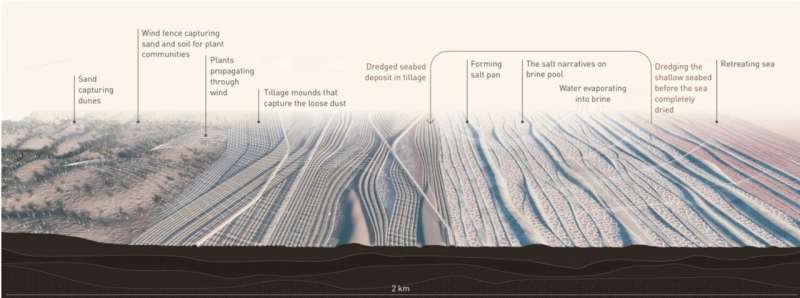This article has been reviewed according to Science X's editorial process and policies. Editors have highlighted the following attributes while ensuring the content's credibility:
fact-checked
proofread
Researcher introduces strategies to sustain aesthetics and performance in anthropogenic landscapes

Entering the Anthropocene, humans are confronted with a grim yet peculiar state of increasing natural landscapes inching closer to extinction. Notably, the Aral Sea retains a mere 10% of its original volume, highlighting the urgency of the situation.
The Aral Sea, originating at the end of the Neogene Period and fed by the Amu Darya and Syr Darya rivers with meltwater from the Tianshan Mountains, was once the fourth-largest lake in the world. Intensive water diversion for cotton plantation across Uzbekistan, Kazakhstan, and Turkmenistan since the 1960s has resulted in its significant reduction. Meanwhile, the desiccation of the Aral Sea leads to the emergence of a new desert—Aralkum Desert.
This transformation introduces sand, salt, and dust across the Aral Sea Basin, causing salty dust storms that carry toxic pesticides from cotton fields, leading to respiratory issues, soil degradation, and decreased crop productivity in nearby areas. Moreover, the disappearance of this substantial water body has altered regional climate, resulting in colder winters and hotter summers, and accelerated the melting of adjacent glaciers.
The desiccation of the Aral Sea foretells the increasingly frequent experience of losing landscapes, ecosystems, and existing cultural man-land relationships.
An article, "Designing the Demise of Aral Sea: Strategies to Sustain Aesthetics and Performance in Anthropogenic Landscapes" and published in the journal of Landscape Architecture Frontiers, challenges conventional ways of landscape conservation which aim to halt or reverse ecological degradation. Instead, it proposes a paradigm where the design for the anthropogenic landscape in the Aral Sea is not to solely conserve what is left, but rather allows a dignified decline.
In the design of anthropogenic post-human landscape for the Aral Sea, we can make human devastation noticeable by revealing the slow death of the lake. These markers shall be memorials and educational tools guiding us to properly adapt to Aral Sea's evolving ecosystem. They aim to document the gradual ecological changes, fostering new forms of coexistence between humans and non-humans, as well as highlighting the significant impact of human activities on the planet.
This project integrates local materials, including salt-tolerant plants, sand, water, and iron, honoring the site's inherent characteristics. It outlines four strategic approaches—stasis, accumulation, slowing down, and amplifying decay—to developing Anthropo-makers with respective design programs and travel modes.
The proposed design interventions involve creating a system of brine pools, tillage mounds, sand-capturing dunes, and ecological markers, and seek to employ non-human entities, including both inorganic and organic materials like sand, salt, and plantings, in mitigating the demise of the Aral Sea.
In essence, this article strives to make human devastation in the Anthropocene perceptible by designing an educative experience while slowing the disappearance of the dying sea.
More information: Ellena Oi Ling Wong, Designing the Demise of Aral Sea: Strategies to Sustain Aesthetics and Performance in Anthropogenic Landscapes, Landscape Architecture Frontiers (2024). DOI: 10.15302/J-LAF-1-050058
Provided by Higher Education Press





















